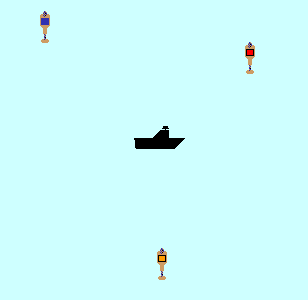How is sound used to navigate underwater?
Underwater sound can be used to help ships navigate their way through the water. Sound can also be used to navigate remotely operated vehicles (ROVs), manned submersibles, and oceanographic equipment.
A basic underwater navigation system uses a hydrophone and an acoustic tracking beacon. The hydrophone is attached to a boat, below the water and works like an antenna. The beacon, somewhere below the boat, transmits a signal that is picked up by the hydrophone. The system calculates the range (distance) and bearing (horizontal direction) to the beacon. The position of the beacon is determined relative to the boat. If the exact location of the boat is known, then the exact location of the beacon can be calculated.

The position of the Remotely Operated Vehicle (ROV) is calculated using a transducer that is attached to the ship and a beacon attached to the ROV. (Courtesy of Kongsberg-Simrad)
A more precise underwater navigation system uses several beacons. A ship or ROV has an acoustic transducer that combines a transmitter and a receiver. Beacons that make a pinging sound are spread out on the ocean floor in known locations. These special beacons are called transponders. The transducer sends out signals to the underwater transponders. Each transponder responds with a unique sound of its own. These replies are picked up by the transducer. Computers then calculate the exact position of the ship or ROV by determining the distance from the beacons and using simple geometry and basic math.

Remotely Operated Vehicle (ROV) navigating using a network of underwater transponders. (Courtesy of Kongsberg-Simrad)
How position is calculated
Underwater positioning is based on the basic principle:
Distance = Speed x Time, where Speed is the speed of sound in water.
The system measures the amount of time between the initial ping (sent from the transducer) and the return ping (received from the transponder) and calculates the distance from that transponder:
The product is divided by two because the measured time is the round-trip time (from the transducer to the transponder and back to the transducer).
Once you get 3 distances from 3 known points, you can calculate the position using a method called triangulation. Computers calculate the unique point where all three distances measured from the transponders intersect.

Factors affecting underwater navigation
Many things affect underwater navigation. The speed of sound changes with temperature, so it must be measured in different areas and at different times throughout the day. Differences in temperature in the water result in thermoclines– regions of the water column that separate warm surface water from cold deep water. These thermoclines may deflect the sound. In addition, there may be noises from the ship or other objects that interfere with measuring the underwater signals.
Additional Resource
- Dive and Discover – Sound is the Answer to Underwater Navigation.